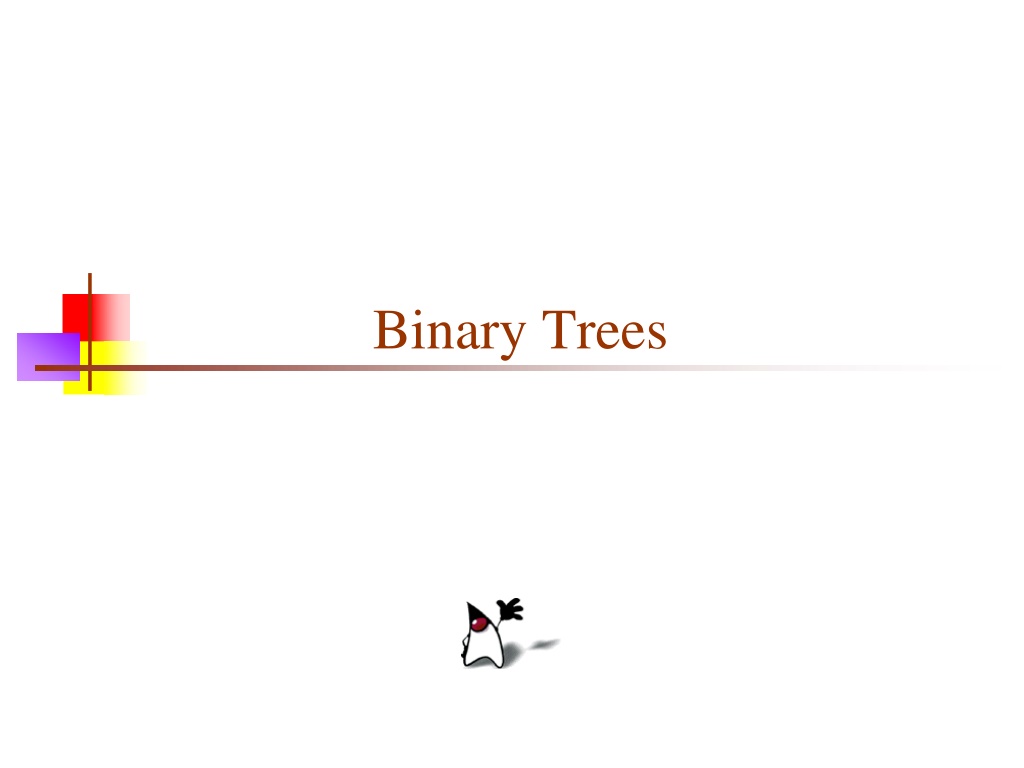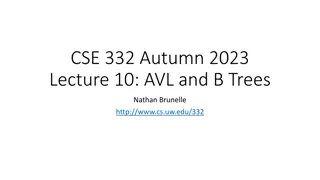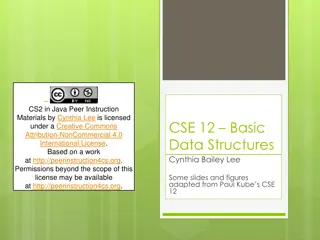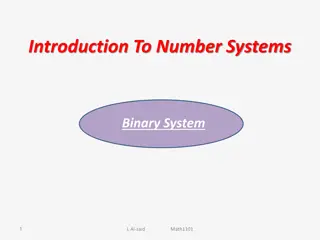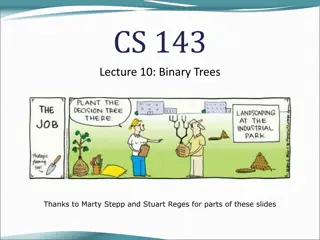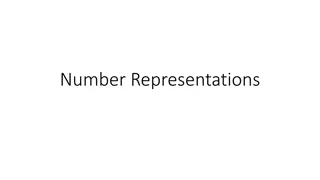Understanding Binary Trees in Java
Binary trees are a fundamental data structure in Java composed of nodes with values and references to left and right children. Nodes have specific relationships like parent-child, ancestor-descendant, and sibling. The size and depth of a binary tree determine its structure, and balancing is essential for efficient operations. Learn more about binary trees and their terminology.
Download Presentation

Please find below an Image/Link to download the presentation.
The content on the website is provided AS IS for your information and personal use only. It may not be sold, licensed, or shared on other websites without obtaining consent from the author. Download presentation by click this link. If you encounter any issues during the download, it is possible that the publisher has removed the file from their server.
E N D
Presentation Transcript
Parts of a binary tree A binary tree is composed of zero or more nodes In Java, a reference to a binary tree may be null Each node contains: A value (some sort of data item) A reference or pointer to a left child (may be null), and A reference or pointer to a right child (may be null) A binary tree may be empty (contain no nodes) If not empty, a binary tree has a root node Every node in the binary tree is reachable from the root node by a unique path A node with no left child and no right child is called a leaf In some binary trees, only the leaves contain a value 2
Picture of a binary tree The root is drawn at the top a b c d e f j k g h i l 3
Left Right The following two binary trees are different: A A B B In the first binary tree, node A has a left child but no right child; in the second, node A has a right child but no left child Put another way: Left and right are not relative terms 4
More terminology Node A is the parent of node B if node B is a child of A Node A is an ancestor of node B if A is a parent of B, or if some child of A is an ancestor of B In less formal terms, A is an ancestor of B if B is a child of A, or a child of a child of A, or a child of a child of a child of A, etc. Node B is a descendant of A if A is an ancestor of B Nodes A and B are siblings if they have the same parent 5
Size and depth The size of a binary tree is the number of nodes in it a This tree has size 12 b c The depth of a node is its distance from the root d e f a is at depth zero e is at depth 2 g h i j k The depth of a binary tree is the depth of its deepest node l This tree has depth 4 6
Balance a a b c b c e d e f g d f h i j g h A balanced binary tree i j An unbalanced binary tree A binary tree is balanced if every level above the lowest is full (contains 2n nodes) In most applications, a reasonably balanced binary tree is desirable 7
Sorted binary trees A binary tree is sorted if every node in the tree is larger than (or equal to) its left descendants, and smaller than (or equal to) its right descendants Equal nodes can go either on the left or the right (but it has to be consistent) 10 8 15 4 12 20 17 8
Binary search in a sorted array Look at array location (lo + hi)/2 Searching for 5: (0+6)/2 = 3 Using a binary search tree hi = 2; (0 + 2)/2 = 1 lo = 2; (2+2)/2=2 7 3 13 0 1 2 3 4 5 6 2 3 5 7 11 13 17 2 11 17 5 9
Tree traversals A binary tree is defined recursively: it consists of a root, a left subtree, and a right subtree To traverse (or walk) the binary tree is to visit each node in the binary tree exactly once Tree traversals are naturally recursive Since a binary tree has three parts, there are six possible ways to traverse the binary tree: root, right, left right, root, left right, left, root root, left, right left, root, right left, right, root 10
class BinaryTree class BinaryTree<V> { V value; BinaryTree<V> leftChild; BinaryTree<V> rightChild; // Assorted methods } A constructor for a binary tree should have three parameters, corresponding to the three fields An empty binary tree is just a value of null Therefore, we can t have an isEmpty() method (why not?) 11
Preorder traversal In preorder, the root is visited first Here s a preorder traversal to print out all the elements in the binary tree: public void preorderPrint(BinaryTree bt) { if (bt == null) return; System.out.println(bt.value); preorderPrint(bt.leftChild); preorderPrint(bt.rightChild); } 12
Inorder traversal In inorder, the root is visited in the middle Here s an inorder traversal to print out all the elements in the binary tree: public void inorderPrint(BinaryTree bt) { if (bt == null) return; inorderPrint(bt.leftChild); System.out.println(bt.value); inorderPrint(bt.rightChild); } 13
Postorder traversal In postorder, the root is visited last Here s a postorder traversal to print out all the elements in the binary tree: public void postorderPrint(BinaryTree bt) { if (bt == null) return; postorderPrint(bt.leftChild); postorderPrint(bt.rightChild); System.out.println(bt.value); } 14
Tree traversals using flags The order in which the nodes are visited during a tree traversal can be easily determined by imagining there is a flag attached to each node, as follows: preorder inorder postorder To traverse the tree, collect the flags: A A A B C B C B C D E F G D E F G D E F G A B D E C F G D B E A F C G D E B F G C A 15
Copying a binary tree In postorder, the root is visited last Here s a postorder traversal to make a complete copy of a given binary tree: public static BinaryTree copyTree(BinaryTree bt) { if (bt == null) return null; BinaryTree left = copyTree(bt.leftChild); BinaryTree right = copyTree(bt.rightChild); return new BinaryTree(bt.value, left, right); } 16
Copying a binary tree Many programs use copy constructors a constructor that constructs a new object that is a copy of the given object Here s a copy constructor for nonempty binary trees: public BinaryTree(BinaryTree bt) { value = bt.value; if (bt.leftChild != null) { leftChild = new BinaryTree(bt.leftChild); } if (bt.rightChild != null) { rightChild = new BinaryTree(bt.rightChild); }; } Notice the tests to avoid nullPointerExceptions! 17
Other traversals The other traversals are the reverse of these three standard ones That is, the right subtree is traversed before the left subtree is traversed Reverse preorder: root, right subtree, left subtree Reverse inorder: right subtree, root, left subtree Reverse postorder: right subtree, left subtree, root 18
The End 19
